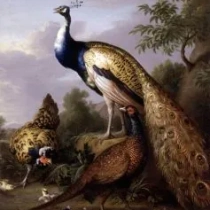Windflowers 1903
"Windflowers" (1903) by John William Waterhouse is a captivating painting that beautifully embodies the Pre-Raphaelite and Romantic styles for which the artist is renowned. This artwork stands out in Waterhouse's oeuvre as a celebration of feminine beauty and the natural world, intertwining mythological and classical themes with a deep, almost mystical reverence for nature.
The painting depicts a young woman in a flowing gown, surrounded by a swirl of windflowers, also known as anemones. These flowers, which according to Greek mythology were created by the goddess Aphrodite as she mourned the death of Adonis, add a layer of symbolic depth to the painting. The woman, with her downcast eyes and contemplative expression, seems to be in a state of introspection or mourning, creating a poignant connection between her and the mythological origins of the windflowers.
Waterhouse's use of color in "Windflowers" is masterful. The soft, ethereal palette lends the painting a dreamlike quality, with the delicate pinks, purples, and greens of the windflowers contrasting beautifully with the woman's rich, red gown. This juxtaposition not only highlights the figure but also emphasizes the fleeting, ephemeral beauty of the flowers, echoing the transient nature of youth and life itself.
The composition of the painting is notable for its fluidity and grace. The way the woman's gown seems to merge with the windflowers creates a sense of harmony and unity between the human figure and the natural world. This seamless integration reflects Waterhouse's fascination with the Romantic ideal of nature as a powerful, enigmatic force that is both beautiful and melancholic.
Furthermore, Waterhouse's skill in rendering textures and details is evident in "Windflowers." The delicate rendering of the woman's gown, the soft petals of the flowers, and the subtle play of light and shadow all contribute to the painting's lifelike quality and visual appeal.
In essence, "Windflowers" is a poetic and deeply evocative work that showcases John William Waterhouse's unique ability to blend classical and mythological themes with a profound appreciation for natural beauty. This painting is not just a visual delight; it is a narrative that speaks of love, loss, and the timeless allure of nature, marking it as one of the most enchanting pieces in Waterhouse's celebrated body of work.







No Comments Yet...